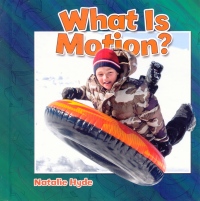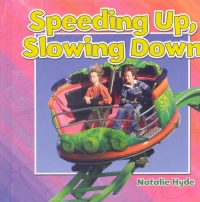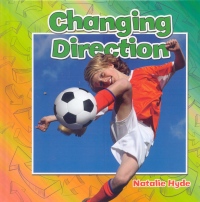| ________________
CM . . .
. Volume XXI Number 26. . . .March 13, 2015

 |
What is Motion? (Motion Close-Up).
Natalie Hyde.
St. Catharines, ON: Crabtree, 2014.
24 pp., pbk., hc., pdf & html, $8.95 (pbk.), $18.36 (RLB.).
ISBN 978-0-7787-0531-4 (pbk.), ISBN 978-0-7787-0527-7 (RLB.), ISBN 978-1-4271-9020-8 (pdf), ISBN 978-1-4271-9016-1 (html).
Subject Heading:
Motion-Juvenile literature.
Kindergarten-grade 2 / Ages 5-7.
Review by Harriet Zaidman.
** /4
|
| |
|
 |
Speeding Up, Slowing Down. (Motion Close-Up).
Natalie Hyde.
St. Catharines, ON: Crabtree, 2014.
24 pp., pbk., hc., pdf & html, $8.95 (pbk.), $18.36 (RLB.).
ISBN 978-0-7787-0534-5 (pbk.), ISBN 978-0-7787-0530-7 (RLB.), ISBN 978-1-4271-9023-9 (pdf), ISBN 978-1-4271-9019-2 (html).
Subject Heading:
Speed-Juvenile literature.
Kindergarten-grade 2 / Ages 5-7.
Review by Harriet Zaidman.
** /4
|
| |
|
 |
Pushing and Pulling. (Motion Close-Up).
Natalie Hyde.
St. Catharines, ON: Crabtree, 2014.
24 pp., pbk., hc., pdf & html, $8.95 (pbk.), $18.36 (RLB.).
ISBN 978-0-7787-0533-8 (pbk.), ISBN 978-0-7787-0529-1 (RLB.), ISBN 978-1-4271-9022-2 (pdf), ISBN 978-1-4271-9018-5 (html).
Subject Headings:
Force and energy-Juvenile literature.
Power (Mechanics)-Juvenile literature.
Motion-Juvenile literature.
Kindergarten-grade 2 / Ages 5-7.
Review by Harriet Zaidman.
** /4
|
| |
|
 |
Changing Direction. (Motion Close-Up).
Natalie Hyde.
St. Catharines, ON: Crabtree, 2014.
24 pp., pbk., hc., pdf & html, $8.95 (pbk.), $18.36 (RLB.).
ISBN 978-0-7787-0532-1 (pbk.), ISBN 978-0-7787-0528-4 (RLB.), ISBN 978-1-4271-9021-5 (pdf), ISBN 978-1-4271-9017-8 (html).
Subject Headings:
Motion-Juvenile literature.
Force and energy-Juvenile literature.
Kindergarten-grade 2 / Ages 5-7.
Review by Harriet Zaidman.
** /4
|
| |
|

excerpt:
Some objects move back and forth. First, they move in one direction and then they move in the opposite direction. A rocking chair moved back and forth when it rocks. Waves also move back and forth at the beach. (From What is Motion?)
Teachers are always on the lookout for resources to support their classroom teaching of curricular topics such as forces and motion. It’s essential that these resources be accurate and precisely written to be worth parting with schools’ always-meager book budgets.
The “Motion Close-Up” series published by Crabtree does not measure up to that standard. Incomplete explanations and missed opportunities make this set of four 24-page, photographically illustrated hardcover books an unimportant option.
Consider the above excerpt: the concept of back and forth affords this book the chance to use and teach the word ‘reverse’ and explain the meaning. Specific terms are printed in bold type, but instead of being defined in a glossary at the back of the book, the words are merely reprinted on the final page as in index, referring the reader back to where the word originally appeared. But the title of the back page is “‘Words to know’ and ‘Index’”.
Other words are poorly explained and illustrated. In the following example, a tugboat is shown approaching a cruise boat from the side: “A strong push will make something move farther or faster. A tugboat can push a huge cruise ship.” (Changing Direction) The example chosen to illustrate the concept is in contrast to the everyday examples used in the rest of the series (kids playing, kids engaged in sports, riding bikes, etc). A tugboat pushing a giant cruise ship in the middle of its hull is hardly something all children will be able to digest and internalize, and, in this illustration, there is no pushing motion demonstrated – the vessels are a distance apart.
Another example: “An object will keep moving in a straight line unless a new force acts on it. Another force will make the motion of the object change.” (Changing Direction) The photograph taken from grass-level shows a boy kicking a soccer ball, but the text does not explain that the grass is another force affecting the trajectory of the ball.
In Speeding Up, Slowing Down, the concept of friction is inadequately explained. A slide does not create a lot of friction. But the reason - that the material the slide is made of is slippery - is not explained. A bicycle’s brakes use friction to help control the bike’s speed. If you press gently on the brakes, the bike will slow down. Why? The reader is not informed that squeezing the brake forces an object (the brake) against the tire, causing it to spin more slowly. On the page titled “Rough and Smooth,” a partial explanation of friction is provided, but with a very poor example: “The rougher the surface is, the more friction it creates. Sandpaper is very rough. You cannot slide on sandpaper.”
No matter how many people this reviewer has polled, no one admitted to ever attempting to slide anywhere on sandpaper.
Page 24 includes “Notes for adults and an activity” - fairly elementary kinaesthetic activities that will help kids understand the concept. Other books are suggested, as are websites, some with very long addresses to type in and which prove to have a very high content level in comparison to the targeted age level of the books.
Overall, this series explains the concept of motion inconsistently. Teachers should be aware of its weaknesses before committing to its purchase or before using it in the classroom.
Recommended with Reservations.
Harriet Zaidman is a teacher-librarian in Winnipeg, MB.

To comment
on this title or this review, send mail to cm@umanitoba.ca.
Copyright © the Manitoba Library Association. Reproduction for personal
use is permitted only if this copyright notice is maintained. Any
other reproduction is prohibited without permission.
Next Review | Table of Contents For This Issue - March 13, 2015
CM Home | Back Issues
| Search
| CM Archive
| Profiles Archive
|



